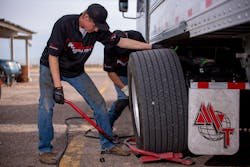This past October, the North American Council for Freight Efficiency (NACFE) updated it 2015 Confidence Report on low rolling resistance (LRR) tires. NACFE defined rolling resistance as the force needed to keep the tire rolling at a constant speed on a level surface. LRR tires refer to any tire on the SmartWay-verified list, though some tires on that list will have an even lower resistance than others. LRR tires include all wide-base tires and many dual tires.
These types of tires have an improved rolling resistance coefficient (RRC), calculated by dividing the force needed to keep a tire moving by the relative weight felt where the rubber meets the road. The variables in the equation include tire pressure and velocity. The lower that coefficient is, the less fuel energy is required to overcome any resistance to keep the tires rolling. That ends up equaling less money spent at the fuel pump.
The U.S. Environmental Protection Agency, which runs the SmartWay certification program, has put an emphasis on technology such as LRR tires for its greenhouse gas Phase 2 regulations, which call for improvements in tires and aerodynamics, for example.
Regulations aside, NACFE’s 59-page paper made clear that long-haul fleets simply cannot afford to ignore or under-value LRR tires.
“Even though the upfront costs of low rolling resistance tires may be higher, the cost of the fuel that a tire consumes due to its rolling resistance is five times greater than the initial purchase price of the tire,” explained Mike Roeth, executive director at NACFE.
Roeth said that fuel efficiency offsets initial costs that are “recovered over the tire’s operational lifetime.”
The math bears this out. As stated in NACFE’s data as of April 2020, a fleet’s average fuel cost per mile is 43 cents, assuming $2.48 per gallon for diesel. Tire costs are just under 4 cents per mile. According to tire manufacturers, the fuel expended to overcome an aerodynamic Class 8 truck tires’ rolling resistance at highway speed owns a third of that, or 14 cents. When using tires with higher rolling resistance, that could account for 28 cents per mile. For this reason, fleets need to calculate the whole tire equation, which includes several variables, from manufacturer to route to geography. Typically, these are best suited for the long-haul segment and low-scrub applications.
It can be complicated, but fleets are beginning to run more scientific tests, crunch the numbers, and discover immense gains.
Third-party tester MVT Solutions, a subsidiary of Mesilla Valley Transportation, which routinely validates tires and aero kits, recently found the complement of fuel efficiency-boosting equipment that included LRR tires could dramatically cut costs for one large fleet.
“In one day of testing, we found them $55 million a year in savings,” said Daryl Bear, lead engineer and chief operating officer of MVT Solutions. “And every dollar of that equals greenhouse gases that are not being emitted.”
Bear said the testing cost the confidential fleet $3,000, with vendors picking up some of the total tab.
“The biggest problem is that fuel savings have just been very difficult to measure in trucking,” Bear said. “People just haven’t been informed. But then the second part of it is that they also don’t know how to calculate fuel savings from tires. There’s a science to it.”
Less resistance to adoption
LRR tires, which in the 1980s were called low-profile tires, had failed to gain a high adoption rate because of their lower tread depth and shorter lifespan as well as lower traction performance. They offered improved fuel efficiency of 3 to 4% but at a 15% higher initial cost with 30% less tread life. With fuel prices at $1.50 per gallon, the math didn’t add up.
That has changed as fuel costs have increased and manufacturing technology has evolved.
“Over the last five or 10 years, the tire manufacturers have really done a great job of redesigning the tires to get the low rolling resistance, but get longer wear and do well on traction and braking,” Roeth said.
Michelin’s recently launched X One Line Energy T2 trailer tire utilizes a dual-compound tread design to prevent irregular wear and compounds that resist late-life tire aggression. It has reduced rolling resistance by 11% while allowing the trailer to carry an extra 287 lbs. of payload.
Meanwhile, the PRO Series LHT trailer tire from Cooper Tire is designed with an improved casing for optimal value and multiple retreads. Gone are the days of merely comparing tire cost to miles driven, said Phil Mosier, Cooper Tire’s manager of commercial tire development. The real driver of total cost of ownership (TCO) is the fuel efficiency component.
“Fuel efficiency has a much greater impact on the value to the fleet than the original price they paid for the tire or even treadwear,” he said.
Truck makers are also reporting a higher interest due to the improvement in tread wear and performance. NACFE reported 80% of new trucks and trailers now spec LRR tires.
“One of the easiest ways to improve fuel economy is simply to spec an [LRR tire],” said Jim Nachtman, Navistar’s marketing director of the heavy-duty product segment. “We are seeing a lot more conversations going on between the customer and International, where the customers are asking us to make recommendations on tires to improve fuel economy. We do think moving forward, there will be greater shift for fleets moving toward [LRR tires].”
In Part II, we'll explore the different tre OEMs and how to choose the right LRR tires.
About the Author
John Hitch
Editor
John Hitch is the editor-in-chief of Fleet Maintenance, providing maintenance management and technicians with the the latest information on the tools and strategies to keep their fleets' commercial vehicles moving. He is based out of Cleveland, Ohio, and was previously senior editor for FleetOwner. He previously wrote about manufacturing and advanced technology for IndustryWeek and New Equipment Digest.



